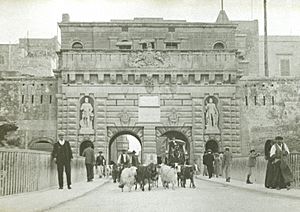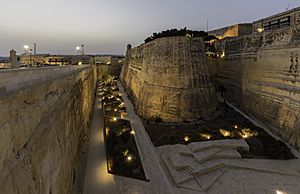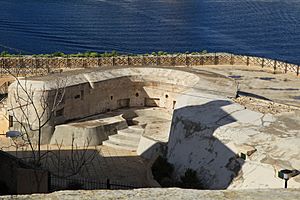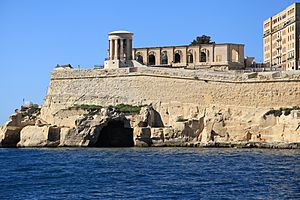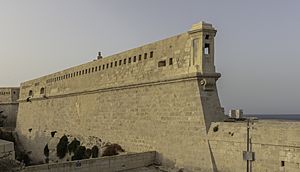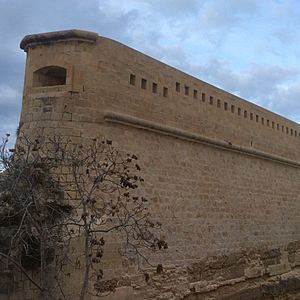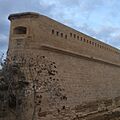Fortifications of Valletta facts for kids
Quick facts for kids Fortifications of Valletta |
|
|---|---|
| Is-Swar tal-Belt Valletta | |
| Valletta, Malta | |
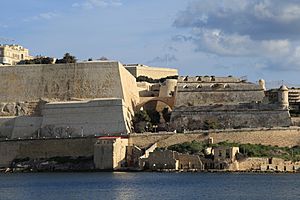
Valletta Land Front as seen from Manoel Island
|
|
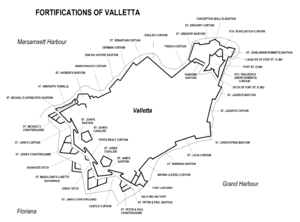
Map of Valletta's fortifications
|
|
| Coordinates | 35°53′50″N 14°30′31.5″E / 35.89722°N 14.508750°E |
| Type | City wall |
| Site information | |
| Owner | Government of Malta |
| Open to the public |
Yes |
| Condition | Mostly intact |
| Site history | |
| Built | 1566–1570s |
| Built by | Order of Saint John British Empire (some modifications) |
| In use | 1571–1970s |
| Materials | Limestone |
| Battles/wars | French invasion of Malta (1798) Siege of Malta (1798–1800) World War II |
| Events | Rising of the Priests |
| Type | Cultural |
| Criteria | i, vi |
| Designated | 1980 (4th session) |
| Part of | City of Valletta |
| Reference no. | 131 |
| Region | Europe and North America |
The fortifications of Valletta are a strong set of walls and defenses that surround Valletta, the capital city of Malta. These walls were built to protect the city from attacks. The very first part, Fort Saint Elmo, was built in 1552. But the main city walls started being built in 1566. This was when Grand Master Jean Parisot de Valette founded the city.
Over the years, the defenses were made even stronger. The last big addition was Fort Lascaris, finished in 1856. Most of these old walls are still standing today. Valletta's defenses were so famous that they might have even inspired parts of the Fortress of Luxembourg. In 1878, Valletta was called "one of the best fortified cities in the world." Today, these amazing fortifications are part of a UNESCO World Heritage Site.
Contents
History of Valletta's Fortifications
Why Were the Fortifications Built?
People first thought about building a strong city on the Sciberras Peninsula way back in 1524. At that time, there was only a small watchtower there. The Order of St. John, who ruled Malta, decided to focus on strengthening Birgu instead. Birgu was their main base.
In 1551, the Ottoman Empire attacked Malta. They also took over Gozo and Tripoli. This made the Knights realize they needed better defenses. So, in 1552, they built Fort Saint Elmo where the old watchtower stood. This fort became very important during the Great Siege of Malta in 1565. Even though the fort fell after tough fighting, the Knights held on in Birgu until help arrived.
Building the City Walls
After winning the Great Siege, the Knights got money from all over Europe. They used this money to build a new capital city on the Sciberras Peninsula. An Italian engineer named Francesco Laparelli was hired to design the city's defenses. He planned a strong wall system with special towers called cavaliers and a deep ditch. The city itself was planned with a grid plan of streets.
The first stone of the new city was laid on March 28, 1566. The city was named Valletta after Grand Master Jean Parisot de Valette. The city walls were among the first things built. They were mostly finished by the 1570s. Fort Saint Elmo, which was badly damaged in the siege, was also rebuilt and became part of the city's walls. Valletta officially became the capital of Malta in 1571. By the end of the 1500s, it was the biggest place on the island.
How the Fortifications Were Improved
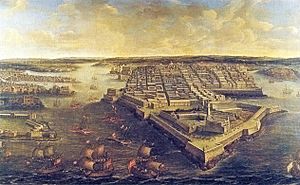
In the 1600s and 1700s, Valletta's defenses were made even stronger. They added more outer defenses like counterguards, a hidden path called a covertway, and a sloping area called a glacis. The northern part of the peninsula, including Fort St. Elmo, also got new walls. These were built in the late 1680s to stop attacks from the sea.
Even with these changes, people knew Valletta's walls might not be strong enough for a long siege. So, in 1635, they started building the Floriana Lines. These were another set of strong walls that protected Valletta's land side. Over time, a town called Floriana grew up between these new lines and Valletta's walls.
Other forts were also built to protect the city's sides. These included Santa Margherita Lines, Cottonera Lines, and Fort Ricasoli on the Grand Harbour side. On the Marsamxett side, Fort Manoel and Fort Tigné were built.
Valletta Under French and British Rule
Valletta's fortifications were first used in battle during the French invasion of Malta in 1798. The Knights gave up after only three days. Valletta and its defenses were handed over to the French. When Napoleon saw the strong walls, he reportedly said, "I am very glad that they opened the gate for us."
A few months later, the Maltese people rebelled against the French. They, with help from the British, Neapolitans, and Portuguese, trapped the French in the harbor area. The French held out in Valletta until September 1800. Then, General Claude-Henri Belgrand de Vaubois surrendered to the British, who took control of Malta.
The British made many changes to Valletta's fortifications. The biggest was building Fort Lascaris between 1854 and 1856. They also added new gun positions and changed parts of the walls. All three of the original gates into Valletta were taken down. Two of them were replaced with bigger gates.
In the 1800s, the British thought about tearing down parts of the fortifications many times. But in the end, most of the walls stayed. Only a small part called St. Madeleine's Lunette was removed. This was near the city entrance, where the Triton Fountain is now.
The fortifications were no longer used for defense by the late 1800s or early 1900s. Some parts, like Fort St. Elmo and the Saluting Battery, were still used until after World War II. Fort St. Elmo stopped being used in 1972. In the 1960s, a 19th-century gate called Porta Reale was taken down to build a new, modern City Gate.
Valletta's Fortifications Today
In 2006, plans were made to restore Valletta's fortifications. This was part of a big project to fix up many old forts in Malta. The restoration work started in 2010. It was called "the biggest in a century." Parts of Fort Saint Elmo have been restored. A small chapel that was bombed in World War II was rebuilt in 2014.
In 2011, the City Gate built in the 1960s was taken down. A new City Gate was finished in 2014.
Layout of Valletta's Fortifications
The Land Front Defenses
The Valletta Land Front is a large, strong wall system. It protects the city from the land side. It includes:
- St. Michael's Bastion: A half-bastion on the west side. It is now part of Hastings Gardens.
- St. John's Curtain: The wall connecting St. Michael's and St. John's Bastions. Also part of Hastings Gardens.
- St. John's Bastion: A big bastion with a small watchtower. It is also part of Hastings Gardens.
- St. John's Cavalier: A five-sided tower overlooking St. John's Bastion. It is now an embassy.
- Porta Reale Curtain: The wall between St. John's and St. James Bastions. The city's main gate is here. The gate has been rebuilt five times. The current one was finished in 2014.
- St. James Bastion: Another large bastion with a watchtower. It is now used by the Central Bank of Malta.
- St. James Cavalier: A five-sided tower overlooking St. James Bastion. It is now a cultural center.
- Castile Curtain: The wall connecting St. James and St. Peter & Paul Bastions. Part of its top has been removed for a road.
- St. Peter and St. Paul Bastion: A two-level corner bastion on the east side. The top part is now the Upper Barrakka Gardens. The lower part has the Saluting Battery. Fort Lascaris is below this bastion.
A deep ditch surrounds the entire land front.
The bastions are also protected by outer defenses:
- St. Michael's Counterguard: A three-level defense built in 1640. It has a small chapel that was rebuilt in 2014.
- St. John's Counterguard: A five-sided defense built in 1640. It has a watchtower and a gunpowder storage room. It is now a football ground.
- St. Madeleine's Lunette: A small defense that protected the city entrance. It was removed in the 1800s. The Triton Fountain is now in its place.
- St. James Counterguard: A five-sided defense built in 1640. It has a watchtower and a gunpowder storage room.
- St. Peter and St. Paul Counterguard: A two-level defense built in 1640. It has a watchtower and a gunpowder storage room.
Marsamxett Harbour Defenses

The walls along the Marsamxett Harbour side start from St. Michael's Bastion and go to Fort St. Elmo. They include:
- St. Andrew Tenaille: A small defense below St. Michael's Bastion.
- St. Andrew's Bastion: An uneven five-sided bastion. It used to have a gate that was removed in the early 1900s.
- Manderaggio Curtain: The wall connecting St. Andrew's and San Salvatore Bastions. It was once open for ships but was later walled up.
- San Salvatore Bastion: A flat-faced platform for cannons. It has many World War II air raid shelters inside.
- German Curtain: A small wall north of San Salvatore Bastion. It also has air raid shelters.
- St. Sebastian Curtain: Another small wall north of the German Curtain, with air raid shelters.
- English Curtain: A long wall near St. Elmo Bay. It has a secret exit and air raid shelters.
- French Curtain: A long wall near St. Elmo Bay, connected to Fort Saint Elmo.
Grand Harbour Defenses

The walls along the Grand Harbour side start from St. Peter and St. Paul Bastion and go to Fort St. Elmo. They include:
- Fort Lascaris: A strong battery built by the British between 1854 and 1856. The Lascaris War Rooms are nearby.
- Marina Curtain: The wall connecting St. Peter & St. Paul and St. Barbara Bastions. It used to have a gate that was replaced by Victoria Gate in the 1800s.
- St. Barbara Bastion: A flat-faced bastion with a low wall. It has a small watchtower.
- St. Lucia Curtain: The wall connecting St. Barbara and St. Christopher Bastions.
- St. Christopher Bastion: A two-level five-sided bastion. It is now broken through for the Valletta ring road. The top part is the Lower Barrakka Gardens. The bottom part has the Siege Bell War Memorial.
- St. Lazarus Curtain: The wall connecting St. Christopher and St. Lazarus Bastions.
- St. Lazarus Bastion: A flat-faced bastion with British gun positions and a storage room.
Fort Saint Elmo

Fort Saint Elmo is the oldest part of Valletta's walls. It guards the entrance to both the Grand Harbour and Marsamxett Harbour. The fort and its surrounding area include:
- Upper St. Elmo: This is the original star-shaped fort. It has two half-bastions, a parade ground, and a large cavalier.
- Vendôme Bastion: A bastion built in 1614. It has a watchtower and is now part of the National War Museum.
- Carafa Enceinte: These are the walls built around the fort after 1687. They include:
- St. Gregory Bastion: An uneven bastion that was changed by the British for cannons.
- St. Gregory Curtain: A wall connecting St. Gregory and Conception Bastions. It has British gun positions.
- Conception Bastion: A small five-sided bastion with gun positions and storage rooms.
- Sta. Scholastica Curtain: A wall connecting Conception and St. John Bastions. It has a gun position for a very large cannon.
- St. John Bastion: A large, uneven bastion at the very tip of the peninsula. It has British gun positions and storage rooms.
- St. Ubaldesca Curtain: A long wall connecting St. John and St. Lazarus Bastions. It has British gun positions.
There are also old barracks (buildings for soldiers) in the area between Upper St. Elmo and the Carafa Enceinte.
Images for kids
-
The enceinte along Marsamxett Harbour
-
The enceinte along the Grand Harbour
-
Fort Saint Elmo with the entrance to Marsamxett to the right
See also
 In Spanish: Fortificaciones de La Valeta para niños
In Spanish: Fortificaciones de La Valeta para niños



